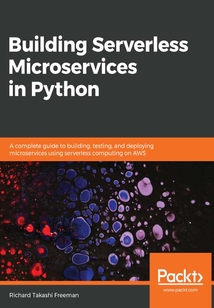舉報(bào) 

會(huì)員
Building Serverless Microservices in Python
Overthelastfewyears,therehasbeenamassiveshiftfrommonolithicarchitecturetomicroservices,thankstotheirsmallandindependentdeploymentsthatallowincreasedflexibilityandagiledelivery.Traditionally,virtualmachinesandcontainersweretheprincipalmediumsfordeployingmicroservices,buttheyinvolvedalotofoperationaleffort,configuration,andmaintenance.Morerecently,serverlesscomputinghasgainedpopularityduetoitsbuilt-inautoscalingabilities,reducedoperationalcosts,andincreasedproductivity.BuildingServerlessMicroservicesinPythonbeginsbyintroducingyoutoserverlessmicroservicestructures.YouwillthenlearnhowtocreateyourfirstserverlessdataAPIandtestyourmicroservice.Movingon,you'lldelveintodatamanagementandworkwithserverlesspatterns.Finally,thebookintroducesyoutotheimportanceofsecuringmicroservices.Bytheendofthebook,youwillhavegainedtheskillsyouneedtocombinemicroserviceswithserverlesscomputing,makingtheirdeploymentmucheasierthankstothecloudprovidermanagingtheserversandcapacityplanning.
目錄(163章)
倒序
- coverpage
- Title Page
- Copyright and Credits
- Building Serverless Microservices in Python
- About Packt
- Why subscribe?
- Packt.com
- Dedication
- Contributors
- About the author
- Packt is searching for authors like you
- Preface
- Who this book is for
- What this book covers
- To get the most out of this book
- Download the example code files
- Download the color images
- Conventions used
- Get in touch
- Reviews
- Serverless Microservices Architectures and Patterns
- Understanding different architecture types and patterns
- The monolithic multi-tier architecture and the monolithic service-oriented architecture
- Benefits of monolithic architectures
- Drawbacks of the monolithic architectures
- Overview of microservices
- Benefits and drawbacks of microservice architectures
- SOA versus microservices
- Virtual machines containers and serverless computing
- Virtual machines
- Containers
- Serverless computing
- Comparing virtual machines containers and serverless
- Overview of microservice integration patterns
- Design patterns
- Why are patterns useful?
- Software design patterns and principles
- Serverless microservices pattern categories
- Communication styles and decomposition microservice patterns
- Communication styles
- One-to-one communication microservice patterns
- Many-to-many communication microservice patterns
- Decomposition pattern by business capability
- Decomposition pattern by bounded context
- Serverless computing in AWS
- Overview of some of the key serverless services in AWS
- AWS Lambda
- Serverless computing to implement microservice patterns
- Example use case – serverless file transformer
- Setting up your serverless environment
- Setting up your AWS account
- Setting up MFA
- Setting up a new user with keys
- Managing your infrastructure with code
- Installing bash on Windows 10
- Updating Ubuntu installing Git and Python 3
- Installing and setting up the AWS CLI
- Summary
- Creating Your First Serverless Data API
- Overview of security in AWS
- Why is security important?
- Security by design principles
- AWS Identity and Access Management
- JavaScript object notation
- IAM policies
- IAM users
- IAM groups
- IAM roles
- Securing your serverless microservices
- Lambda security
- API Gateway security
- DynamoDB security
- Monitoring and alerting
- Find out more
- Building a serverless microservice data API
- Serverless microservice data API requirements
- Query string
- Data API architecture
- Setting up Lambda security in the AWS Management Console
- Creating an IAM policy
- DynamoDB IAM policy
- Lambda IAM policy
- Creating the Lambda IAM role
- Creating and writing to a NoSQL database called DynamoDB using AWS
- Creating a DynamoDB in AWS
- Writing data to DynamoDB using AWS
- Querying DynamoDB using AWS
- DynamoDB Scan in AWS Management Console
- DynamoDB Query in AWS Management Console
- Deleting DynamoDB using AWS
- Creating and writing to a NoSQL database called DynamoDB using Python
- Creating a DynamoDB table using Python
- Writing to DynamoDB using Python
- Querying DynamoDB using Python
- Creating a Lambda to query DynamoDB
- Creating the Lambda function
- Testing the Lambda function
- Setting up the API Gateway and integrating it with a Lambda proxy
- Connecting API Gateway Lambda and DynamoDB
- Cleaning-up
- Summary
- Deploying Your Serverless Stack
- An overview of serverless stack build and deploy options
- Manually provisioning infrastructure
- Infrastructure as code
- Building and deploying using the Serverless Application Model (SAM)
- Building and deploying using alternate options
- Creating a profile an S3 bucket IAM policies and IAM roles resources
- Creating an AWS credentials profile
- Creating an S3 bucket
- Setting up the configuration files for your AWS account
- Updating the polices and assuming roles files
- Creating the IAM roles and policies
- Checking the IAM roles and policies
- Building and deploying with API Gateway Lambda and DynamoDB
- Building the Lambda as a ZIP package
- SAM YAML template
- Packaging and deploying your serverless stack
- Putting it all together
- Manually testing the serverless microservice
- Making code and configuration changes
- Deleting the serverless stack
- Summary
- Testing Your Serverless Microservice
- Unit testing your Python Lambda code
- Why is testing important?
- Types of testing
- Unit testing Lambda Python code
- The sample test data
- The unit test
- Mocking
- Running the unit test
- Code coverage
- Running and debugging your AWS Lambda code locally
- Batch-loading data into DynamoDB
- Running the Lambda locally
- Integration testing using real test data
- Testing that a Lambda has been deployed correctly
- Testing that API Gateway has been deployed correctly
- The AWS Serverless Application Model CLI
- Loading and end-to-end testing at scale
- Load testing your serverless microservice
- Strategies to reduce the API's latency
- Cleaning up
- Summary
- Securing Your Microservice
- Overview of the security in AWS
- Why is security important?
- Types of security terms in AWS
- Overview of AWS Identity and Access Management (IAM)
- IAM users
- IAM groups
- IAM roles
- Securing your serverless microservice
- Lambda security
- DynamoDB security
- Monitoring and alerting
- Summary
- Summary and Future Work
- Book summary
- Future work
- Other Books You May Enjoy
- Leave a review - let other readers know what you think 更新時(shí)間:2021-06-24 15:57:53
推薦閱讀
- 電影中的精神病學(xué)
- 胃腸間質(zhì)瘤科普教育手冊(cè)
- 腦卒中預(yù)防與控制
- 超聲醫(yī)學(xué)專科能力建設(shè)專用初級(jí)教材:介入分冊(cè)
- 狡猾的細(xì)胞:癌癥的進(jìn)化故事與治愈之道
- 圖說災(zāi)難逃生自救叢書:海嘯
- 前列腺癌標(biāo)準(zhǔn)數(shù)據(jù)集(2021版)
- 常見惡性腫瘤治療原則與實(shí)施方案
- Android Studio 4.0 Development Essentials(Java Edition)
- 顱腦7.0T磁共振成像診斷學(xué)
- 實(shí)用人體體表解剖全真圖解
- 病人家屬,請(qǐng)來一下(譯文科學(xué))
- 藥學(xué)監(jiān)護(hù)典型案例分析
- 圖解骨傷科痛癥治療手法
- 中西醫(yī)結(jié)合腎臟病學(xué)研究新進(jìn)展
- 干燥綜合征
- 國(guó)民視覺健康報(bào)告
- 臨床生物化學(xué)檢驗(yàn)
- 新編臨床眼科學(xué)
- 兒童口腔科臨床病例解析
- 神經(jīng)病學(xué)新進(jìn)展
- 口腔健康 從我做起:第四次全國(guó)口腔健康流行病學(xué)調(diào)查結(jié)果解讀大眾版
- WebRTC Integrator's Guide
- 圖說災(zāi)難逃生自救叢書:泥石流
- 口腔健康教育
- 圖解舌診
- 多發(fā)性骨髓瘤(第3版)
- Mastering Splunk
- 視盤病變(第2版)
- 現(xiàn)代皮膚科學(xué)

